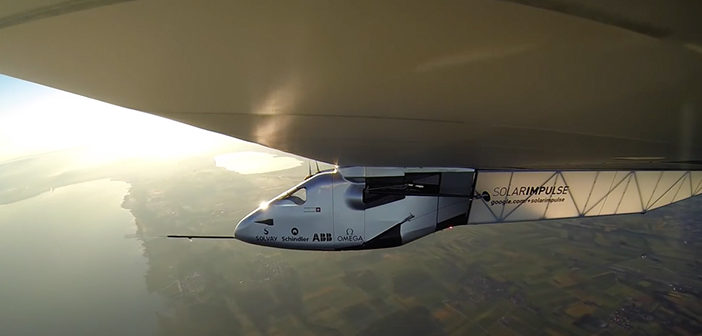Solar Impulse is a Swiss long-range experimental solar-power aircraft project, the star of a first in the energy history.
The wingspan of Solar Impulse 2 is 71.9 m (236 ft), slightly less than that of an Airbus A380, the world’s largest passenger airliner, but compared with the 500-ton A380, the carbon-fibre Solar Impulse weighs only about 2.3 tonnes (5,100 lb), little more than an average SUV. It features a non-pressurized cockpit 3.8 cubic metres in size and advanced avionics, including an autopilot to allow for multi-day transcontinental and trans-oceanic flights.
Supplemental oxygen and various other environmental support systems allow the pilot to cruise up to an altitude of 12,000 metres (39,000 ft).
It was the impossible dream. Then Bertrand Piccard and André Borschberg made it real: the first round the world solar flight, without a drop of fuel, using solar power, is now history.
Four continents, two oceans, three seas: 26,000 miles is the lenght of the flight, 23 are the flight days. On a solar power fueled airplane.
Bertrand Piccard claimed that this is not just the first time in the aviation history, but first of all this is a first in the energy history.
What Solar Impulse demonstrated is the possibility to use in our daily life all the technologies we used in aviation. Co2 emissions will be lowered down to 50% and there is no need to cut on profits.
A new Utopia? A beautiful scene from science fiction? No, a cutting-edge technological challenge! A sufficiently eccentric project to appeal to one’s emotions and get one’s adrenalin pumping: to harness a clean and renewable form of energy, and use it to fly night and day without limit.
Here you have some images filmed with GoPro
And this is the mighty reel of the final landing in Abu Dhabi at the end of the mission.
Surely their Facebook Page is a interesting resource to be updated on what the team is working on and to find green economy resources.
« The problem with our society is that, despite all the grand talk about sustainable development, we are a long way from making use of the clean technologies that are already available to us. Those solutions bring opportunities to create jobs, make profit, sustain the growth of the industry, and at the same time protect the environment. »
Bertrand Piccard



